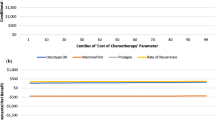Abstract
Various methods have been proposed to address uncertainty in economic evaluations of healthcare programmes. One approach suggested in the literature is to estimate separate confidence intervals for the incremental costs and effects of a new health programme in comparison with an existing programme. These intervals are then combined to generate a rectangular confidence region in the cost-effectiveness plane that implicitly defines a corresponding confidence interval for the incremental cost-effectiveness ratio (ICER). The same approach has been used to calculate sample sizes and study power. This application of the rectangle method is consistent with the adoption of ICERs and a threshold as a decision rule, this being the most commonly used approach in empirical applications of cost-effectiveness analysis, as well as the one recommended by agencies that assess medical technology around the world.
In this paper, we first outline the rectangle method, and then propose a modification that recognises that separate inferences are being drawn on the cost and effectiveness domains, and that corrects for multiple statistical comparisons. The confidence rectangle is otherwise too small, the corresponding confidence interval for the ICER is too narrow and sample sizes are under-estimated. Our modification corrects these problems.
A further difficulty is that the placement of the confidence rectangle around the null value is somewhat arbitrary, and does not correspond to a unique value of ICERs. As a result, different values of sample size and power for the estimation of ICERs can be obtained, depending on the null values of the cost and effectiveness. We conclude that it is important to clearly identify the analytic goal in terms of estimating differential costs, differential effects or a combination of the two using the ICER index. These ideas are illustrated using numerical examples.








Similar content being viewed by others
References
Gardiner J, Huebner M, Jeton J, et al. Power and sample size assessments for test hypotheses on cost-effectiveness ratios. Health Econ 2000; 9: 227–234
Backhouse ME. Use of randomized controlled trials for producing cost-effectiveness evidence. Pharmacoeconomics 2002; 20: 1061–1077
Briggs AH, Gray AM. Power and sample size calculations for stochastic cost-effectiveness analysis. Med Dec Making 1998; 18 Suppl.: S81–S92
Willan A, O’Brien B. Sample size and power issues in estimating incremental cost-effectiveness ratios from clinical trials data. Health Econ 1999; 8: 203–211
Fieller EC. Some problems in interval estimation. J Royal Statist Soc, Series B, 1954; 16: 175–183
Laska E, Meisner M, Siegel C. Power and sample size in cost-effectiveness analysis. Med Dec Making 1999; 19: 339–343
Al M, Van Hout B, Michel B, et al. Sample size calculations in economic evaluations. Health Econ 1998; 7: 327–335
Hoch JS, Briggs AH, Willan AR. Something old, something new, something borrowed, something blue: a framework for the marriage of health econometrics and cost effectiveness analysis. Health Econ 2002; 11: 415–430
Briggs AH, O’Brien BJ, Blackhause G. Thinking outside the box: recent advances in the analysis and presentation of uncertainty in cost-effectiveness studies. Am Rev Public Health 2002; 23: 377–401
Birch S, Gafni A. On being NICE in the UK: guidelines for technology appraisal for the NHS in England and Wales. Health Econ 2002; 11: 185–191
Gafni A, Birch S. Inclusion of drugs in provincial drug benefit programs: should’ reasonable decisions’ lead to uncontrolled growth in expenditures? Can Med Assoc J 2003; 168: 849–851
Sendi P, Gafni A, Birch S. Opportunity costs and uncertainty in the economic evaluations of health care programs. Health Econ 2002; 11: 23–31
O’Brien B, Gertsen K, Willan A, et al. Is there a kink in consumers’ threshold value for cost-effectiveness in health care? Health Econ 2002; 11: 175–180
Cook RJ, Dunnett CW. Multiple comparisons. In: Armitage P, Colton T, editors. Encyclopedia of biostatistics. New York: Wiley, 1999: 2736–2746
Sidak Z. Rectangular confidence regions for the means of multivariate normal distributions. J Am Stat Assoc 1967; 62: 626–633
Polsky D, Glick HA, Willke R, et al. Confidence intervals for cost-effectiveness ratios: a comparison of four methods. Health Econ 1997; 6: 243–252
Birch S, Gafni A. Cost effectiveness/utility analysis: do current decision rules lead us to where we want to be? J Health Econ 1992; 11: 279–296
Birch S, Gafni A. Changing the problem to fit the solution: Johannesson and Weinstein’s (mis)application of economics to real world problems. J Health Econ 1993; 12: 469–476
Claxton K. The irrelevance of inference: a decision-making approach to the stochastic evaluation of health care technologies. J Health Econ 1999; 18 (3): 341–364
Acknowledgements
No funding was used for the preparation of this manuscript. The authors declare they have no conflicts of interest directly relevant to the contents of this paper.
Author information
Authors and Affiliations
Corresponding author
Rights and permissions
About this article
Cite this article
Walter, S.D., Gafni, A. & Birch, S. Estimation, Power and Sample Size Calculations for Stochastic Cost and Effectiveness Analysis. Pharmacoeconomics 25, 455–466 (2007). https://doi.org/10.2165/00019053-200725060-00002
Published:
Issue Date:
DOI: https://doi.org/10.2165/00019053-200725060-00002




